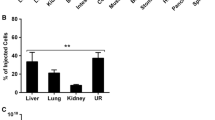The features of B16 melanoma progression in male C57BL/6 mice with initially high and low resistance to hypoxia were studied. To assess the resistance to hypoxia, the mice were placed in a low-pressure chamber at a simulated altitude of 10,000 m. One month after testing, B16 melanoma was inoculated to high- and low-resistant animals. In 19 days after melanoma transplantation, the severity of melanoma progression was assessed by morphological and immunofluorescent methods. The expression of vegf-a and hif-1a in the liver of melanomabearing and control mice was evaluated by real-time PCR. Tumor growth progression was more pronounced in low-resistant mice, which was seen from high weight of the primary tumor node, relative necrosis area, proliferation rates (mitotic index and number of Ki-67+ cells), and expression of vegf-a gene in the liver. In high-resistant to hypoxia animals, the number of caspase-3+ cells dying by apoptosis was higher. The data on more rapid melanoma progression in mice with low resistance to hypoxia should be considered during the search of new prognostic markers and methods for therapy of malignant neoplasms.
Similar content being viewed by others
References
Georgiev GP. Molecular and genetic mechanisms of tumor progression. Sorosovsk. Obrazovat. Zh. 2000;6(11):1-6. Russian.
Luk’yanova LD. Molecular mechanisms of tissue hypoxia and adaptation. Fiziolog. Zh. 2003;49(3):17-35. Russian.
Lyzhko NA. Molecular-genetic mechanisms of initiation, promotion and progression of tumors. Ross. Bioter. Zh. 2017;16(4):7-17. Russian.
Pavlov KA, Gershtein ES, Dubova EA, Shchegolev AI. Vascular endothelial growth factor and type 2 receptor for this factor in vascular malformations. Bull. Exp. Biol. Med. 2011;150(4):481-484.
Manual on Immunohistochemical Diagnostics of Human Tumors. Kazan, 2012. Russian.
Freshney RI. Culture of Animal Cells. Moscow, 2010. Russian.
Almendros I, Montserrat JM, Torres M, Dalmases M, Cabañas ML, Campos-Rodríguez F, Navajas D, Farré R. Intermittent hypoxia increases melanoma metastasis to the lung in a mouse model of sleep apnea. Respir. Physiol. Neurobiol. 2013;186(3):303-307.
Burghoff S, Gong X, Viethen C, Jacoby C, Flögel U, Bongardt S, Schorr A, Hippe A, Homey B, Schrader J. Growth and metastasis of B16-F10 melanoma cells is not critically dependent on host CD73 expression in mice. BMC Cancer. 2014;14. ID 898. doi:https://doi.org/10.1186/1471-2407-14-898
Fidler IJ. Selection of successive tumour lines for metastasis. Nat. New Biol. 1973;242(118):148-149.
Fidler IJ, Nicolson GL. Organ selectivity for implantation survival and growth of B16 melanoma variant tumor lines. J. Natl Cancer Inst. 1976;57(5):1199-1202.
Graham K, Unger E. Overcoming tumor hypoxia as a barrier to radiotherapy, chemotherapy and immunotherapy in cancer treatment. Int. J. Nanomedicine. 2018;13:6049-6058.
Loizzi V, Del Vecchio V, Gargano G, De Liso M, Kardashi A, Naglieri E, Resta L, Cicinelli E, Cormio G. Biological pathways involved in tumor angiogenesis and bevacizumab based anti-angiogenic therapy with special references to ovarian cancer. Int. J. Mol. Sci. 2017;18(9). pii: E1967. doi: https://doi.org/10.3390/ijms18091967
Semenza GL. Defining the role of hypoxia-inducible factor 1 in cancer biology and therapeutics. Oncogene. 2010;29(5):625-634.
Thiersch M, Swenson ER. High altitude and cancer mortality. High Alt. Med. Biol. 2018;19(2):116-123.
Vaupel P, Harrison L. Tumor hypoxia: causative factors, compensatory mechanisms, and cellular response. Oncologist. 2004;9(Suppl. 5):4-9.
Author information
Authors and Affiliations
Corresponding author
Additional information
Translated from Byulleten’ Eksperimental’noi Biologii i Meditsiny, Vol. 168, No. 9, pp. 365-370, September, 2019
Rights and permissions
About this article
Cite this article
Fridman, I.A., Ponomarenko, E.A., Makarova, O.V. et al. Morphological Characteristic of Melanoma B16 Progression in C57BL/6 Mice with High and Low Resistance to Hypoxia. Bull Exp Biol Med 168, 390–394 (2020). https://doi.org/10.1007/s10517-020-04716-w
Received:
Published:
Issue Date:
DOI: https://doi.org/10.1007/s10517-020-04716-w




